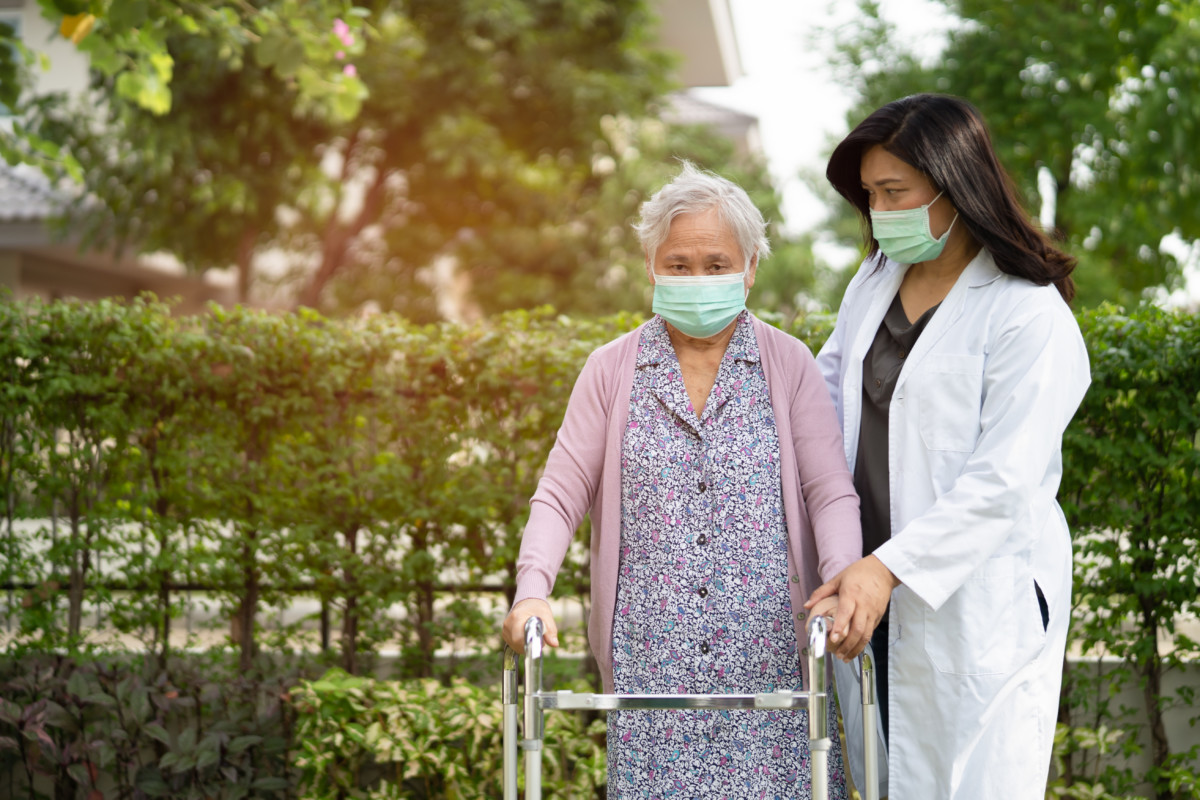How Physical Therapy Reduces the Negative Effects of COVID-19

As we learn more about COVID-19, one thing is becoming clear: physical activity helps fight COVID-19.
Recent research suggests physical therapy can reduce mortality rates in patients hospitalized with COVID-19. The study, which was presented at the Association of Academic Physiatrists Annual Meeting, compared hospitalized patients who did and did not receive physical therapy.
The retrospective study – meaning the interventions that occurred before the research question being developed – included 1,314 patients from a single hospital. The patients were admitted between March 1 and May 31, 2020.
The two groups – those who received physical therapy (PT) and those who did not – differed significantly. The PT group was older (average 74.04 compared to 60.63 years old), had more comorbidities (higher rates of hypertension, diabetes, and heart disease), and had a lower level of physical function before hospitalization (measured by the level of independence). Despite the head start of better overall health the non-PT group possessed, the group that received PT had better outcomes.
The mortality rate for the PT group was 12% while the non-PT group was 25%. Receiving PT did more than level the playing field. Granted, the non-PT group may have had even lower mortality rates – perhaps in the single digits – if they had received PT.
Why don’t more patients hospitalized with COVID-19 receive physical therapy?
Sandeep Yerra, MBBS, Research Fellow, Physical Medicine and Rehabilitation, at Montefiore Hospital, one of the researchers for this study, reasons, “many patients did not receive therapy because of staffing and PPE [personal protective equipment] shortages.”
As equipment stores are replenished and COVID-19 rates drop, staffing and PPE should cease to be barriers. Dr. Yerra concluded “physical therapy should be considered in the treatment paradigm of COVID-19 patients. It is a non-expensive, safe and effective treatment tool that should be considered in every COVID admission”.
How much PT?
According to a recent study, more is better. Another retrospective study, this one assessing 312 patients across 11 hospitals, concluded more frequent and longer PT visits in the hospital resulted in improved mobility at hospital discharge and a higher probability of discharging home.
These studies build off additional research showing the power of physical activity to fight COVID-19.
Physical Activity Builds Resilience
Remember how the PT group overcame the lower prior level of function? If you simply break down the patients into categories of independent, modified independent, requiring moderate assistance, and totally dependent, a clear association is noted. The same researchers found patients with higher levels of function before COVID have lower mortality rates and earlier discharge.
Once the variable of PT in the hospital is added, the lower functioning group achieves better outcomes. However, if you break down the PT group to the level of functioning, it is likely you will see the same trend: more activity leads to better outcomes.
Unfortunately, we are unable to review all the data as the study is only in poster format. If it is published in a journal in the future, we will be able to provide a deeper dive.
Being retrospective data, we cannot draw firm conclusions. It is possible other variables not assessed could be the true driver of improved outcomes; however, previous studies support the idea that physical activity is protective against COVID-19.
Build Your Cardiorespiratory Fitness
A recent study showed an individual’s maximal exercise capacity — how hard they can physically work — is inversely related to hospitalization secondary to COVID-19.
Respiratory viral infections — like COVID-19 — negatively impact the cardiopulmonary system. Cardiorespiratory fitness (exercise capacity) indicates a greater cardiopulmonary reserve and supports the body’s ability to respond to an insult (such as a respiratory viral infection).
The study included 246 adults. Each study participant was pulled from a pool of 21,196 people who completed an exercise stress test between January 1, 2016, and February 29, 2020. From that pool of people, 1,183 were tested for COVID-19 from February 29, 2020, to May 30, 2020. A total of 246 tested positive for COVID-19.
The more physically fit someone is, the less likely they are to be hospitalized by COVID-19. More specifically, the odds of hospitalization decreased by 13% for every one MET higher of exercise capacity.
A MET — or metabolic equivalent — is a measure of how much energy your body is using. By measuring how much oxygen your body uses, researchers can quantify the intensity of exercise. If you are fit, you can exercise at a higher capacity, meaning you can reach a higher MET level.
The more physically fit someone is, the more resilient and protective their body is. I am not saying someone who regularly exercises is immune to COVID-19 or hospitalizations, but the odds of experiencing severe complications greatly lowers. This study builds on the mounds of evidence that support the benefits of cardiovascular fitness.
Using Physical Therapy to Fight COVID-19
Physical therapists receive advanced training in exercise and rehabilitation. They can design personalized programs to build physical resilience. If you have pain or functional impairments, a physical therapist can help you address those impairments and design an appropriate exercise program. To learn more, schedule an evaluation at one of our locations.
If you or a loved one are diagnosed with COVID-19, seek physical therapy. Even if you are not hospitalized, physical therapy can help with acute and chronic symptoms. We are still learning about COVID long haulers, but current research suggests physical therapy, occupational therapy, and speech therapy can help. If you have any questions about COVID and these three services, contact us today.
ABOUT THE AUTHOR

Zach Walston (PT, DPT, OCS) grew up in Northern Virginia and earned his Bachelor of Science in Human Nutrition, Foods, and Exercise at Virginia Polytechnic Institute and State University. He then received his Doctorate of Physical Therapy from Emory University before graduating from the PT Solutions’ Orthopaedic Residency Program in 2015.
Zach has numerous research publications in peer-reviewed rehabilitation and medical journals. He has developed and taught weekend continuing education courses in the areas of plan of care development, exercise prescription, pain science, and nutrition. He has presented full education sessions at APTA NEXT conference and ACRM, PTAG, and FOTO annual conferences multiple platforms sessions and posters at CSM.
Zach is an active member of the Orthopedic and Research sections of the American Physical Therapy Association and the Physical Therapy Association of Georgia. He currently serves on the APTA Science and Practice Affairs Committee and the PTAG Barney Poole Leadership Academy.